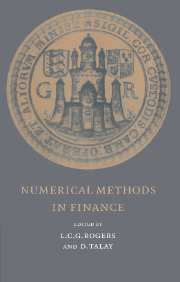Book contents
- Frontmatter
- Contents
- Contributors
- Introduction
- Convergence of Numerical Schemes for Degenerate Parabolic Equations Arising in Finance Theory
- Continuous-Time Monte Carlo Methods and Variance Reduction
- Recent Advances in Numerical Methods for Pricing Derivative Securities
- American Options: A Comparison of Numerical Methods
- Fast, Accurate and Inelegant Valuation of American Options
- Valuation of American Option in a Jump-diffusion Models
- Some Nonlinear Methods for Studying Far-from-the-money Contingent Claims
- Monte Carlo Methods for Stochastic Volatility Models
- Dynamic Optimization for a Mixed Portfolio with Transaction Costs
- Imperfect Markets and Backward Stochastic Differential Equations
- Reflected Backward SDEs and American Options
- Numerical Methods for Backward Stochastic Differential Equations
- Viscosity Solutions and Numerical Schemes for Investment/Consumption Models with Transaction Costs
- Does Volatility Jump or Just Diffuse? A Statistical Approach
- Martingale-Based Hedge Error Control
- The Use of Second-Order Stochastic Dominance To Bound European Call Prices: Theory and Results
Numerical Methods for Backward Stochastic Differential Equations
Published online by Cambridge University Press: 05 June 2012
- Frontmatter
- Contents
- Contributors
- Introduction
- Convergence of Numerical Schemes for Degenerate Parabolic Equations Arising in Finance Theory
- Continuous-Time Monte Carlo Methods and Variance Reduction
- Recent Advances in Numerical Methods for Pricing Derivative Securities
- American Options: A Comparison of Numerical Methods
- Fast, Accurate and Inelegant Valuation of American Options
- Valuation of American Option in a Jump-diffusion Models
- Some Nonlinear Methods for Studying Far-from-the-money Contingent Claims
- Monte Carlo Methods for Stochastic Volatility Models
- Dynamic Optimization for a Mixed Portfolio with Transaction Costs
- Imperfect Markets and Backward Stochastic Differential Equations
- Reflected Backward SDEs and American Options
- Numerical Methods for Backward Stochastic Differential Equations
- Viscosity Solutions and Numerical Schemes for Investment/Consumption Models with Transaction Costs
- Does Volatility Jump or Just Diffuse? A Statistical Approach
- Martingale-Based Hedge Error Control
- The Use of Second-Order Stochastic Dominance To Bound European Call Prices: Theory and Results
Summary
Introduction
Backward stochastic differential equations (BSDEs) were introduced by Pardoux & Peng (1990) to give a probabilistic representation for the solutions of certain nonlinear partial differential equations, thus generalizing the Feynman- Kac formula.
This sort of equation has also found many applications in finance, notably in contingent claim valuation when there are constraints on the hedging portfolios (see El Karoui & Quenez 1995, El Karoui, Peng & Quenez 1994, Cvitanic & Karatzas 1992) and in the definition of stochastic differential utility (see Duffie & Epstein 1992, El Karoui, Peng & Quenez 1994). A financial application of forward-backward SDEs can be found in Duffie, Ma & Yong (1993).
However little research has yet been performed on numerical methods for BSDEs. Here we give a review of three different contributions in that field.
In Section 2, we present a random time discretization scheme introduced by V. Bally to approximate BSDEs. The advantage of Bally's scheme is that one can get a convergence result with virtually no other regularity assumption than the ones needed for the existence of a solution to the equation. However that scheme is not fully numerical and its actual implementation would require further approximations.
In Section 3, we give an account of a four step algorithm developed by J. Ma and P. Protter to solve a class of more general equations called forwardbackward SDEs. It is based on solving the associated PDE by a deterministictype method and also makes use of the Euler scheme for stochastic differential equations.
- Type
- Chapter
- Information
- Numerical Methods in Finance , pp. 232 - 244Publisher: Cambridge University PressPrint publication year: 1997
- 37
- Cited by



